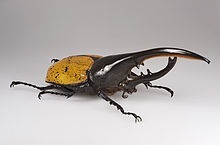The University of Vermont
Physics Department


The University of Vermont
Physics Department
The Hercules Beetle
The Hercules Beetle appears to be a greenish color when the humidity is less than about 80%. As the humidity surpasses this mark, the beetle responds by turning black in color. The reason for this change in color is not understood, however, the prevailing hypothesis is the beetle is green during the day to match the color its tropical environment. The humidity increases during the nights causing the beetle to turn black, decreasing its visibility. This color change is due to the structure of the elytron, or hardened wing covers, of the beetle. The elytron is composed of three major layers, the epicuticle, a clear wax layer 3 um [36.6 S/D] thick containing many cracks. The next two layers form the procuticle a sponge-like layer underneath that is 5 um [22 S/D] thick, and a black layer on the bottom. The yellow/green color arises from the air filled sponge-like layer selectively scattering the yellow/green light. When water, due to high humidity, enters through the cracks in the wax layer, it fills the sponge-like layer. This causes any previously spaces filled with air to be replaced with water which changes the index of refraction to one that matches the outer waxy layer. The light passes through the first two layers without any effects and is absorbed by the third layer black layer. This is known as index matching.
definitions
Cuticle
Scattering
